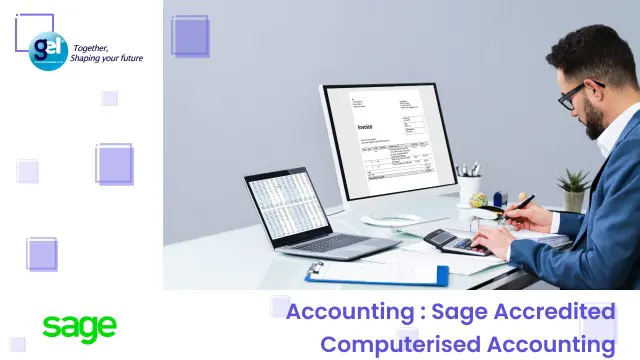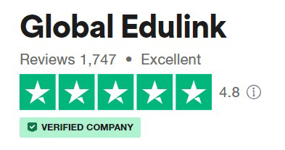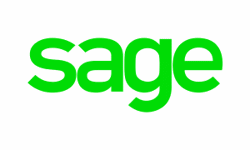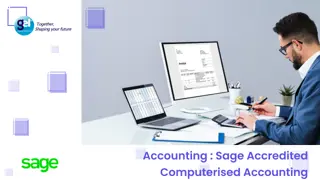
Accounting : Sage Accredited Computerised Accounting
Awarded by SAGE | Free Accredited Certificate Included | Globally Recognised | Unlimited Access for 180 Days | LEVEL 2
Global Edulink
Summary
'ENQUIRE NOW' for more information!
- Exam(s) / assessment(s) is included in price
- Tutor is available to students
- TOTUM card available but not included in price What's this?
Overview
Sage Accredited Computerised Accounting - Level 2
Sage courses focus on accounts and payroll, and could help you to pursue the career you want, and this Computerised Accounting Level 2 Course is no different. The course is very useful to anyone who has a good grasp of the fundamental processes involved in keeping books and financial records. The course will guide learners through using Sage 50 Accounts, from the basics to the more advanced tasks. In addition, you will understand the functionality needed produce invoices and management accounts.
Studying with Global Edulink has many advantages. The course material is delivered straight to you, and can be adapted to fit in with your lifestyle. It is created by experts within the industry, meaning you are receiving accurate information, which is up-to-date and easy to understand.
This course is comprised of professionally narrated e-Learning modules, interactive quizzes, tests and exams. All delivered through a system that you will have access to 24 hours a day, 7 days a week for 6 months. An effective support service and study materials will build your confidence to study efficiently and guide you to secure your qualification.
**PLEASE NOTE: Access to Sage 50c Payroll software for six months (06 months) – extensions to the software are available for a small extra fee.
Course media
Description
Course Objectives
Learn to:
- Set up a new accounting system
- Produce electronic invoices, remittances and statements
- Create detailed management reports to help control a business and increase profitability
- Improve credit and budget control
- Ensure data security and how to keep your system and information fully protected.
COURSE CURRICULUM
Module 01 : Introduction Unit
- Learning Outcomes and Assessment Criteria
- Installation Instructions
- Screenshots, Tasks and Activities
- Working through the Units
- Setting up a New Company
- Backing Up and Restoring Data
- Customise your Company
- How to Use Practice Data
- Helpful Information Using Sage
- Tax Codes within Sage
- The Ledgers and Sage Nominal Codes
- Creating a Chart of Accounts to Suit Company Requirements
- Creating Customer and Supplier Account Codes and Records
- Making Error Corrections and Deleting Transactions
Module 02 : Opening Balances and Journals
- Entering Opening Debtor Balances
- Entering Opening Creditor Balances
- The Use of the Journal
- Making Journal Entries
- Nominal Ledger Opening Balances
- The Opening Trial Balance
Module 03 : Sales and Purchase Ledger Transactions
- Customer Invoices Using Batch Entry
- Customer Credit Notes Using Batch Entry
- Sales Invoice Day Book in Sage
- Sales Credit Day Book in Sage
- Supplier Invoices Using Batch Entry
- Supplier Credit Notes Using Batch Entry
- Purchase Invoice Day Book in Sage
- Purchase Credit Day Book in Sage
- Entering Customer Receipts
- Customer Receipts Reports
- Printing a Customer Statement
- Entering Supplier Payments
- Supplier Payments Reports
- Printing a Remittance Advice
Module 04 : Bank and Petty Cash Transactions
- Process Bank Transactions Not In Customers or Suppliers Ledgers
- Transferring Money Between Accounts
- Recurring Entries
- Bank Reconciliation
- Printing a Bank Statement Report
- Petty Cash Transactions
- Reconciling the Petty Cash Account
Module 05 : The Trial Balance and Data Security
- The Trial Balance
- Errors in the Trial Balance and Bad Debt Write Off
- Maintaining the Security of Data
- Types of Backup Files and Storage
- Setting a System Password
- Exporting Data and Linking to Other Systems
Module 06 : Trade and Settlement Discounts
- Introduction to Discounts
- Customer Trade and Bulk Discounts
- Customer Settlement Discount
- Supplier Settlement Discount
- Customer Receipts and Supplier Payments with Discounts
- Trade and Settlement Discount Additional Exercises
- Answers to Trade and Settlement Discount Additional Exercises
Module 07 : Credit Control, Private Use, Fixed Assets and Budget Control
- Credit Limits and Letters for Credit Control
- Contra Entries
- Private Use of Business Goods
- The Introduction and Purchase of Fixed Assets
- Budget Control
Module 08 : Producing Sales Invoices and Credit Notes
- Producing Sales Invoices
- Producing Sales Credit Notes
- Glossary of Accounting Terms
Method of Assessment
At the end of the course learners will complete self-assessments and a practice test, followed by a final online assessment.
Certification
Those who successfully complete this course will be awarded the Computerised Accounting Level 2 Certificate by Sage UK.
Course Description
This online training course is comprehensive and designed to cover the topics listed under the curriculum.
PLEASE NOTE: We do not provide tutor support for this course
System Requirements
Sage software is not compatible with Windows XP or Apple Macs - unless you are running Windows Vista or Windows 7 via Apple's Boot Camp utility. Sage 50 Accounts v27 - System Requirements
- Processor speed 2Ghz processor or higher.
- RAM (memory) 2 gigabytes (GB) or 4GB RAM if running a 64-bit operating system.
- Free disk space 5GB of free disk space.
- Internet connection
- Windows operating system
- Windows 10 (except Windows 10S), build 1709 or later
- Windows 8.1
- Windows 7
Requirements
- Learners must be age 16 or over and should have a basic understanding of English, Maths, and ICT.
Career path
You can use this certificate to enhance your qualifications for a job in the accounting industry. Listed below are few of the jobs this course will benefit you in, along with the average UK salary per annum.
- Financial Controller – £46,964 per annum
- Chartered Accountant – £35,118 per annum
- Finance Manager – £38,138 per annum
- Accountant – £28,580 per annum
Questions and answers
Reviews
Currently there are no reviews for this course. Be the first to leave a review.
Legal information
This course is advertised on reed.co.uk by the Course Provider, whose terms and conditions apply. Purchases are made directly from the Course Provider, and as such, content and materials are supplied by the Course Provider directly. Reed is acting as agent and not reseller in relation to this course. Reed's only responsibility is to facilitate your payment for the course. It is your responsibility to review and agree to the Course Provider's terms and conditions and satisfy yourself as to the suitability of the course you intend to purchase. Reed will not have any responsibility for the content of the course and/or associated materials.





